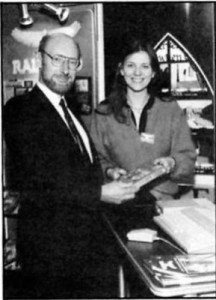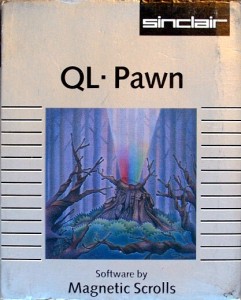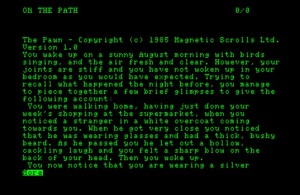Flop though it was in the big picture, the Sinclair QL still managed to attract some tens of thousands of loyal users during its brief commercial lifespan, some of whom still persist with the flawed but oddly endearing little machine to this day. The user base was big enough to support a small commercial software market which included some games on offer. Because the supposedly business-focused QL wasn’t up to all that much graphically, a good proportion of the games were text adventures. Among this group was by far the most remembered piece of software born on the QL — indeed, for a certain group of enthusiasts the only reason the QL is remembered at all. I’m referring of course to The Pawn, the first game from the last of the great 1980s text-adventure houses to emerge, Magnetic Scrolls. Like so many other stories I’ve already told, theirs begins with a few young friends with a shared love of computers and Dungeons and Dragons.
Ken Gordon, Hugh Steers, and Rob Steggles all grew up together in the London suburb of Woolwich. Gordon and Steers were both dedicated hackers. Steggles was less technical, the “tag-along” member of the trio. He did, however, possess another talent which made Gordon and Steers value his company: he had a knack for devising clever scenarios for D&D, which he employed to good effect as Dungeon Master of their little role-playing group. All three were also avid players of adventure games on the computer. They played all the usual suspects in the Britain of the early 1980s, but, crucially, also had exposure to the works of Infocom thanks to the exotic and expensive Apple II the Gordon family owned in preference to the more typical Speccy or BBC Micro. The lives and works of these young men would be shadowed and to some extent guided by the work of that other great adventure-game house across the ocean for years to come. Gordon and Steers spent much time analyzing the Infocom games and tinkering with adventure-game engines and parsers, dreaming of their own games that could live up to the standards of Infocom.
Their hobby would almost certainly have come to nothing more had Gordon not had another friend just a couple of years older, an ambitious and driven young woman named Anita Sinclair who possessed technical talents of her own to go with charm and a flair for business and marketing. Although she was of no relation to Sir Clive, she nevertheless had the perfect name to work at his company. That’s exactly what she did for a time, becoming Sir Clive’s personal aide and one of his firm favorites in the process; their friendship would persist for years, outliving the heydays of both Sinclair Research and Magnetic Scrolls.
Ken, Hugh, and Anita all met in her flat on the evening before Ken and Hugh were to take their A-Levels. There they talked code and business and Hugh demonstrated a parser he had written. The three decided to go into business together writing games for a new platform from which Anita’s keenly honed nose detected the smell of opportunity: the Sinclair QL.
The QL may have been conceived as Sinclair Research’s “professional” machine, but even businesspeople would presumably want to have fun sometimes. Anita initially wanted to make arcade games; they could be finished and released relatively cheaply and quickly. Ken and Hugh, however, had grander ambitions: to form a company and develop the technology to make adventure games that could compete head to head with Infocom. Hugely popular though they were, British adventure games had so far been limited by the more limited British hardware: 48 K or even as little as 32 K of memory rather than the more customary 64 K of North America, and no disk drive to use for virtual memory. Companies like Level 9 had pushed that hardware to incredible places, but there were inevitable limits. The QL, though, came with a full 128 K, a figure which coincidentally was also the maximum size of a game written using Infocom’s Z-Machine virtual machine. Thus the trio could be the first developers in Britain to meet Infocom on a level playing field.
In time Ken and Hugh infected Anita with their bug as well. She thus proposed to Sir Clive that she and her friends deliver a platform-exclusive next-generation adventure game for the QL, to be published by Sinclair themselves to give the game an official blessing of sorts. He agreed. Financing the venture largely through a certain amount of familial wealth that Anita had at her disposal, the trio of friends started Magnetic Scrolls — wonderful name, isn’t it? — in a tiny office in the district of Eltham, southeastern London, in the spring of 1984.
In their technical approach to game-writing as in so much else, they were determined to follow Infocom’s lead as much as possible. In lieu of Infocom’s famous DEC minicomputer, they built a network of four Apple IIs linked to a central hard drive. They used this to write in a subset of 68000 assembly language, which they named ELTHAM: “Extra Low-Tech Highly Ambiguous Metacode,” thus showing if nothing else that they had a sense of humor about the whole endeavor. A cross-compiler translated the ELTHAM code into a form suitable for running on the QL. Over long hours in the cramped office they applied all of the lessons they had learned as hobbyists and Infocom fanatics to an adventure-game engine with a complicated world model and a full-sentence parser the likes of which had never yet been seen from a British developer.
Still, a great adventure is not the result of its technical underpinnings alone. They also needed a game to put in there. Gordon and Steers thought of their old Dungeon Master Rob Steggles, who had just come back home for his first summer break from university (non-technical to the end, he was studying philosophy). Steggles:
They called me up and asked me to write a scenario to run on the system before I went off to university in the autumn. The scenario was The Pawn. What we did with The Pawn was get together as a group and talk for hours until we came up with a whole bunch of disparate, bizarre ideas. We wrote them all on several A1 sheets, put them on the wall, and looked at them for a while. Then I sat down and wrote a story around them.
Steggles then returned to university, where he “thought no more about it.” The others, however, went to work translating his notes into a game. What they had originally conceived as a six-month project turned into a long, hard slog for this group of clever but largely self-taught hackers venturing far into unfamiliar territory without the benefit of Infocom’s grounding in computer science from MIT. They continued to spend at least as much time on their recalcitrant toolchain as the actual game. Anita Sinclair (translated from the German original in Happy Computer magazine by me):
When The Pawn was more or less finished, we began debugging — looking for problems. To help us with that we had another program, a debugger, which worked similarly to a machine-language monitor. Our debugger told us that we had a failure in such and such a place. But no matter how much we pored over the code we couldn’t find the mistake. At last somebody figured out that the debugger itself had a bug.
It took more than a year after Steggles’s involvement ended for the final game to appear under Sinclair’s trademark gray livery in late 1985.
The Pawn is sadly not a game that stands up terribly well almost thirty years later, nor one for which I can muster much affection even after applying the requisite gauzy haze of nostalgia. It received its name late in development from a friend who played it named Tony Lambert, who noted that the player is kept in a constant state of bewilderment and is constantly being used and manipulated by those around him, like a high-fantasy version of The Band’s “The Weight.” And, indeed, The Pawn is a nasty, nihilistic little game with a mean streak unusually wide even for its era. This is a game which delights in breaking certain objects — like, inexplicably, a wooden bowl — when you DROP them without bothering to tell you about it until you try to use them dozens or hundreds of moves later; a game which expects you to commit cold-blooded murder at one point; a game which can’t even be bothered to render up a proper victory screen at the end, but instead lets you spend eternity wandering its landscape as a helplessly homeless ghost. It also has literally some of the worst puzzles I’ve ever seen — and, as you’ve probably gathered by now, I’ve seen a lot of puzzles.
A classic face-palm, almost so bad it’s good, comes in a secret room you discover inside a tree.
>enter door
Tree Trunk Room
You are in a small, cramped room inside the tree trunk. The floor is covered with varnished wooden planks and light filters through the various knots and holes further up the trunk.
There are some boards here. One of the floorboards seems quite loose.
>examine floorboards
The boards are large and very solid.
>examine loose floorboard
I don't understand loose
>lift floorboard
The boards are too heavy to lift.
>get floorboards
The boards are too heavy to lift.
>pull floorboard
You cannot get a grip on the boards
>touch floorboard
The boards are slippery
>slide floorboard
The boards are too heavy to lift.
>pry floorboard with hoe
I don't understand pry
>lever floorboard with hoe
Nothing happens.
>pull floorboard with hoe
You cannot get a grip on the boards
>examine door
The door is heavily camouflaged to make it look like part of the tree.
It is open
>look under door
You find nothing of interest
>close door
The door is now closed.
>lift floorboard
A dark forbidding opening is revealed leading down...
This sequence could almost stand in for the rest of this review, as it so nicely illustrates everything that’s wrong with The Pawn: the parser that’s superficially smart but doesn’t understand basic synonyms like “PRY” (or the more British “PRISE”) for “LEVER”; the world model that doesn’t distinguish between the loose floorboard and the rest of them; the refusal to just tell you what the hell you’re seeing so you can apply some sort of human logic to solving the puzzles. What’s apparently really going on above, if you haven’t gathered it already (and no shame in that), is that the open door was covering the loose board, preventing you from raising it. I must say “apparently,” of course, because the game refuses to tell you a word about something that would be completely obvious to you if you were actually standing there — this even though I’m desperately trying to give it the benefit of the doubt, looking hard at the door for some obscure message. This and some of The Pawn‘s other puzzles deserve to join the worst of Roberta Williams deep, deep down in adventuring hell.
I do want to say a little bit more about the parser because in its own way it’s as wrong-headed as many of the puzzles. Magnetic Scrolls loved to trumpet its ability to handle thorny constructions like “USE THE TROWEL TO PLANT THE POT PLANT IN THE PLANT POT”; in fact, I suspect that the very reason those items exist in the game is to show off the parser. And it worked — reviewers would dutifully type in such sequences when prompted by their press materials and write the requisite amazed copy. The Pawn‘s parser is, however, an absurdly brittle creation. If you know the exact formulations it expects, you can indeed use it in impressive ways. You can, for instance, “TIE THE HOE AND THE RAKE TOGETHER WITH THE TEE-SHIRT.” (This is another puzzle solution that makes no sense to anyone who’s ever seen the real-world analogues of The Pawn‘s hoe, rake, and tee-shirt, but never mind, I’m complaining about something else now.) But what if you try to “TIE SHIRT TO HOE AND RAKE”? Not only does the parser not understand — it misunderstands, leaving you with the shirt tied to the hoe and the last of the command blissfully ignored. Players don’t need a parser that gets all dressed up in its little sailor suit to do fancy tricks for the journalists, then collapses into a tantrum when asked to do a practical job. No, they need one that understands a wide variety of simple, commonsense constructions, and one that when it doesn’t understand doesn’t pretend it does but rather — and this is critical — gives good feedback on exactly what confused it so you can try again forewarned and forearmed. For all its fun with potted plants, The Pawn‘s parser still has a long way to go to match Infocom’s. It can at times be even more challenging to get sense out of than a two-word job because of the combinatorial explosion inherent in finding the exact, idiosyncratic phraseology it expects.
Formally, The Pawn is much more in the mold of Zork than any of Infocom’s later titles: a diverse, nonlinear grab-bag of disparate gags and puzzles and geography held together by little in the way of plot coherence. Some of the humor is kind of dumb but amusing; you play a stoner with a “green design of a plant that has seven jagged-edged leaves” on your tee-shirt, and further references to your love for pot abound (see the “pot plant”) without the game ever just coming out and saying it. (In retrospect I’m surprised that the guardians of adolescent virtue never caught onto this and condemned the game. Perhaps — incredibly! — it was too subtle…) Much of it, though, is just dumb full stop, such as the horse you meet who talks like Mister Ed. (“Get on up. Heyyy, you’re good. D’you ever star in a cowboy movie?”) And the less said about the cameo by Jerry Lee Lewis of all people the better…
As far as I can make out the game wants to be a cutting satire of adventure-game clichés, but its most amusing riffs are themselves lifted from other, smarter commentaries, such as the adventurer from Enchanter (“A tall, handsome man dressed in gleaming armour. He occasionally says things like ‘go north’, ‘get sword,’ and ‘unlight lamp.'”) and the meta-revelations sprinkled throughout the game that it really does all take place inside a computer, a trope that dates back at least to Microsoft’s 1979 version of the Crowther and Woods Adventure. The more original stabs at satire, such as the useless and inescapable maze with a sign outside labeling it “totally irrelevant to the adventure,” cut like a butter knife.
Maybe the kindest thing I can say about The Pawn is that it gave Magnetic Scrolls a suitably low baseline upon which to improve markedly and rapidly in games to come. That they had the opportunity to make more games is largely down to the talent shown by the core trio, particularly Anita Sinclair, for sensing which way the winds were blowing and planning accordingly. As work on the QL version of The Pawn proceeded, it was becoming more and more obvious that that platform was not likely to recover from its disastrous launch sufficiently to support a dedicated adventure-game developer. Luckily, new 68000-based machines were appearing in the form of the Atari ST and the Commodore Amiga; both offered more memory, spectacular graphics capabilities, and much better prospects for commercial success. By the time The Pawn appeared on the QL to predictably underwhelming sales, Anita and company had already initiated the process of porting the game to other machines, a task greatly eased by the development system they had spent so much time building. Soon gamers would look at the company’s early days as a QL-exclusive developer as little more than prehistory, a footnote to the real story.
That’s a story that I’ll be continuing in the course of time. But now it’s time to leave British shores and return Stateside, where an elephant in the room in the form of a certain paradigm-shifting platform introduction has been awaiting his due patiently for a long time now.
(The definitive source for information about Magnetic Scrolls on the Web is the Magnetic Scrolls Memorial, full of contemporary articles and even some memories from Rob Steggles. You can also find the game files themselves and interpreters to run them there. Francesco Cordella’s L’avventura è l’avventura hosts an excellent interview with Steggles. Useful magazine sources: Commodore User of December 1986; Happy Computer of January 1987; ZX Computing of August 1986; Popular Computing Weekly of October 10 1985; Computer and Video Games of October 1987; Home Computing Weekly of May 3 1983; Your Computer of January 1988. The picture at the beginning of this article is from the August 1986 ZX Computing.)












